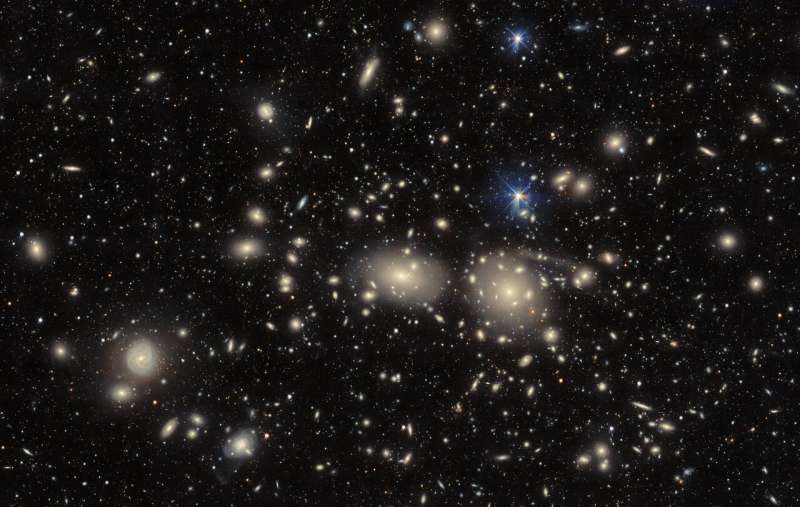This article has been reviewed according to Science X's editorial process and policies. Editors have highlighted the following attributes while ensuring the content's credibility:
fact-checked
proofread
Dark Energy Camera probes the Coma Cluster, an inspiration for the theory of dark matter

The Dark Energy Camera has captured an image of the dazzling Coma Cluster, named after the hair of Queen Berenice II of Egypt. Not only significant in Greek mythology, this collection of galaxies was also fundamental to the discovery of the existence of dark matter.
The theory emerged in 1937 when Swiss astronomer Fritz Zwicky noticed that the Coma Cluster galaxies behaved as if they were under the influence of vast amounts of unobservable "dark" matter.
This densely populated image showcases an enormous cluster not of individual stars, but of entire galaxies, known as the Coma Cluster. The Coma Cluster is named for the constellation in which it lies, Coma Berenices. It is the only one of the 88 IAU constellations to be named after a historical figure. Its namesake is Queen Berenice II of Egypt, or more precisely her hair, with "coma" meaning "hair of the head" in Latin.
Berenice famously cut her hair off and presented it as a votive offering to the gods when her husband returned safely from war. The hair was placed in a temple, but went missing soon after. The court astronomer, Conon of Samos, claimed to identify Berenice's lost tresses in a rather unlikely spot—the night sky—suggesting that the goddess Aphrodite had catasterized (literally turned into a constellation) the queen's locks. This all took place around 245 BCE, meaning that Berenice's hair has enjoyed celestial recognition for an extraordinarily long time.
The data used to build this detailed picture were collected by the Department of Energy-fabricated Dark Energy Camera (DECam), which is mounted on the U.S. National Science Foundation Víctor M. Blanco 4-meter Telescope at Cerro Tololo Inter-American Observatory, a Program of NSF NOIRLab.
The 570-megapixel camera was built to carry out the Dark Energy Survey (DES)—an amazing 758-night run of observations between 2013 and 2019. DES was conducted with the intention to better understand the nature of dark energy—the unknown entity that is causing the expansion of our universe to accelerate.
The Coma Cluster is closely associated with dark energy's equally mysterious counterpart: dark matter. Nearly a century ago, in 1937, Swiss astronomer Fritz Zwicky observed several galaxies within the Coma Cluster. He calculated an approximation of the cluster's mass based on its luminous—in other words, observable—structures.
But he encountered something strange: the cluster seemed to be missing mass. In fact, the galaxies within the cluster were behaving as though the cluster contained 400 times more mass than his estimates suggested.
Zwicky reached this conclusion by observing how fast the galaxies within the cluster were moving. To explain this further, it is helpful to briefly revisit a key point about the nature of gravity. Gravity is one of the four known fundamental interactions that exist between all entities with energy or mass. The more mass that an object has, the stronger the gravitational pull it will exert. Therefore, less massive objects that are within a certain distance to a more massive object will be pulled uncontrollably towards it.
However, there is an additional factor to consider: velocity. If an object is moving fast enough, it can escape the gravitational pull of other objects. It is this principle that enabled Zwicky to infer that the Coma Cluster appeared to be "missing" matter.
He found that the galaxies were moving so fast that they should be escaping the cluster if it were being held together only by the observable mass. This led him to postulate that the cluster must be held together by vast amounts of unobservable "dark" matter, though this suggestion seemed far-fetched to much of the astronomical community.
It took until the 1980s for the majority of astronomers to be convinced of the existence of dark matter. The consensus moved as several studies came out reporting the same curious mass inconsistency that Zwicky observed, but on the scale of single galaxies rather than entire galaxy clusters.
One such study was done in 1970 by U.S. astronomers Kent Ford and Vera C. Rubin, who found evidence of invisible matter in the Andromeda Galaxy. And in 1979, astronomers Sandra Faber and John Gallagher performed a robust analysis of the mass-to-light ratio for over 50 spiral and elliptical galaxies, which led them to conclude that, "the case for invisible mass in the universe is very strong and getting stronger."
The existence of dark matter and dark energy is now widely accepted, and understanding their elusive nature is a main focus of modern astrophysics. A deeper understanding may be on the horizon with the upcoming 10-year Legacy Survey of Space and Time, which will be conducted by NSF–DOE Vera C. Rubin Observatory, named after the inspirational female astronomer who helped show the world that there is so much more to the universe than meets the eye.
Provided by NOIRLab





















